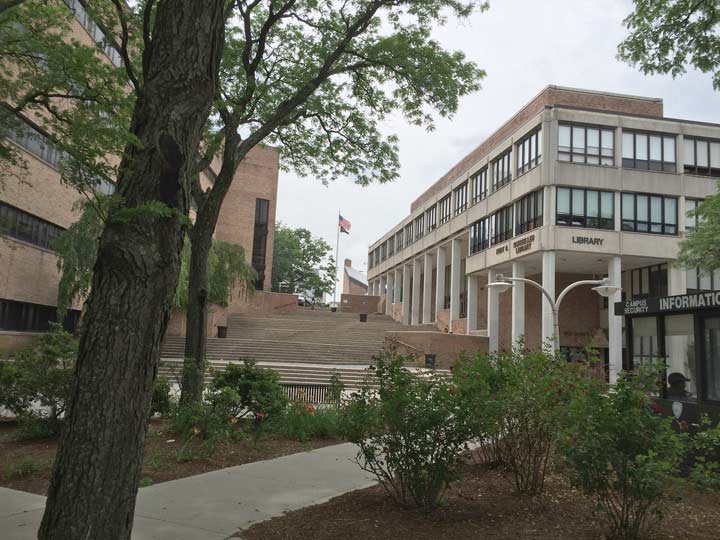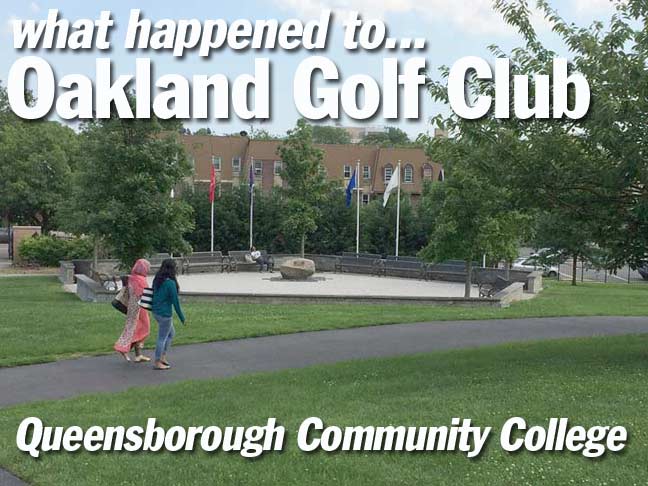By SERGEY KADINSKY
Forgotten NY correspondent
New York City has more colleges than any other city in the county. The campuses vary from the open campuses of New York University and Baruch College, to picturesque academic villages such as Brooklyn College and Fordham University. Some, such as SUNY Maritime and Kingsborough Community College, occupy former military sites. My alma mater, CCNY, is a proud hilltop gothic campus amid tenements and projects.
Queens, once home to nearly a dozen private golf clubs, has seen them transformed into tract housing, middle-class co-ops and two college campuses: St. John’s University and Queensborough Community College. In this story, we’ll visit the latter to see what remains of Oakland Golf Club.

Above: aerial view of Oakland Golf Club, 1924
 Among the five community colleges within the City University of New York, the most spacious campus is the 37-acre Queensborough Community College, which overlooks Oakland Lake. The lake received its water from a natural spring and a feeder stream that originated at 223rd Place and Horace Harding Expressway, flowing into a ravine that widened into the lake. An outflow stream took excess water from the lake, flowing east towards Alley Creek, which emptied into Little Neck Bay.
Among the five community colleges within the City University of New York, the most spacious campus is the 37-acre Queensborough Community College, which overlooks Oakland Lake. The lake received its water from a natural spring and a feeder stream that originated at 223rd Place and Horace Harding Expressway, flowing into a ravine that widened into the lake. An outflow stream took excess water from the lake, flowing east towards Alley Creek, which emptied into Little Neck Bay.
In 1827, land around the pond was purchased by William Douglas and the lake became known as Douglas Pond. His last name can be found today on the map in Douglaston, an upscale neighborhood located a mile to the east of the lake.
The namesake behind the lake’s current name was “The Oaks,” an estate on the lake’s southern shore owned by Frederick Newbold Lawrence. In 1896, the 180-acre Lawrence property was transformed into the Oakland Golf Club and its first game was hosted on April 10, 1897. From its early years, the club welcomed women as members and staff.
The club’s membership included powerbrokers Bernard Baruch, Robert Wagner Sr, and highway promoter Horace Harding. The expressway bearing Harding’s name runs a few blocks to the south of the club and historians speculate that perhaps Harding wanted the road built in order to facilitate easier access between the city and the golf course.
In 1952, the Oakland Golf Club disbanded and the course survived as a city-run public course for another nine years. Most of the course was developed into 600 units of tract housing, with the remaining 14 acres slated for Benjamin N. Cardozo High School and 35 acres for a college campus. The stream that fed into Oakland Lake was buried beneath the school’s running track. An additional school, Public School 203, was built atop the ravine, with a small playground adjoining it.


On the campus of Queensborough Community College, the old golf clubhouse serves as the art gallery, located at the highest point on campus. Around it, stepped paths hug the topography and give students a place to sit.

Below the clubhouse, a mini-quad serves as the center of the campus. A tradition dating back to Thomas Jefferson’s University of Virginia plan, the quad is a series of interlocking paths at the center of a campus designed to foster interaction among students of different disciplines.


In its first decade, the college made history for having the youngest college president in the City University System, when 31-year-old Dr. Kurt R. Schmeller was appointed in 1968. At the time, campuses across the country were rocked by student riots confronting issues such as the Vietnam War, civil rights, admissions standards and tuition. Schmeller had little tolerance for riots on his campus, ordering the termination of two professors who joined a 1969 campus sit-in in support of a fired assistant professor. Schmeller remained president of the college until 1999, earning distinction as the longest tenured president of a public college in the country. The college library carries his name.

The most recent addition to the campus is Kupferberg Holocaust Resource Center, a postmodern structure completed in 2011. Clad in Jerusalem Stone and irregularly shaped panes of glass, the design commemorates the Kristallnacht, the 1938 pogrom in Nazi Germany known as the “night of the broken glass.” The research center provides exhibits, speakers and literature on the holocaust. Prior to its new home, the archives were located in the basement of the Schmeller Library. In its present home, the archives sit on a hill overlooking the southern entrance to the campus.

Along with the modernist buildings, historic clubhouse and Holocaust Resource Center, some of the college’s facilities, such as its bookstore, remain in trailer-like structures that have yet to be replaced with something permanent.
6/24/15


14 comments
Hi- This is pretty a amazing page to me. I attended QCC back in 1966 and it was pretty much a work in progress then. Only one of the permanent buildings was finished at that time and the college had to rent classroom and gym space from two nearby Jewish centers, one of them on the other side of the LIE. Because of the distance, the travel time allowance between classes was 20 minutes. As the gym space was insufficient for the student body, this was solved by substituting ballroom dancing for half of the required gym credits. Most classes were held in temporary buildings, called “portables”, which housed two classrooms each. The portables were located on the hill between the clubhouse and the street (the first hole?) and there were still sand traps near them! The classrooms opened directly to the exterior, so you can imagine what it must have been like during Winter with the students walking in and out. The clubhouse was our cafeteria and it’s old locker room was our library. I transferred to CCNY after one year and found out what a real college was like.
I’ve heard that Horace Harding’s road to his golf club story for decades. But I never heard that the Oakland Club was the objective. The road ran out at least as far as the Lake Success club.
I remember walking past the golf course on our walk to Kiddy City in Douglaston, where they had rides, food and the ability to make a record of your voice, before tape recording became popular.
My alma mater Brooklyn College is another college whose current campus was built on a golf course…
http://www.brooklyn.cuny.edu/web/about/history/ourhistory.php
Thanks for this page. I am a QCC alum from the mid-70’s.
During the time I was there, many of the ‘portables’ were still in use. The Science building was complete, as was the Humanities building. The Library was completed while I was there, and work was started on the Administration building.
One of the things I remember was that the re-routing of the streams did not work out so well. In the years I was there, the main road between the entrance and Springfield Blvd (56th Ave.) flooded a number of times after a heavy rain. The student cars parked on the street were severely damaged. I can recall one downpour that lasted about an hour. When you walked out on the sidewalk, perhaps 60 cars had been flooded, as the water came down from 3 directions and couldn’t drain fast enough. I remember one car where the owner hadn’t gotten to it yet. Water was still draining, but you could see that the level had gotten over the top of the dashboard, and the level inside the car was still up over the seat bottom!
The Phys Ed options at the time were varied. I recall courses being offered on golf and fencing. I took a different course and went bowling. I think it was held at Bayside Lanes.
I was informed that there are actually seven community colleges within CUNY. Expect more “Forgotten-NY on Campus” pages to come.
I just learned that my 1st cousin 2x removed, George R. Easton, was the golf pro at Oakland Golf Club sometime in the mid-1920s.
I walked around the course once with my father. The golf course had many ravines which came into play. Some of the greens were classic, like a punch bowl green.
The clubhouse was located on the highest point on the property. The hills near the clubhouse were a local favorite for sleigh riding. The ride down the hill from the clubhouse was the best.
My father and I played Oakland Golf Course in the early ’60’s. In the winter, the hill from the Club House all the way down into the ravine behind P.S. 203 was an epic sledding run. Another sledding run, from the site of P.S. 203 into the ravine was known as “Dead Man’s Hill”. There was a wooden bridge across the ravine which was a hazard to kids heading into the ravine from both the Club House run and Dead Man’s Hill. Kids also played ice hockey on the huge frozen puddles that formed roughly where the QCC trailer classrooms are now located.
I also remember sledding on “Dead Man’s Hill” on Oakland Golf Course. We were all pretty disappointed when the course closed (not for golf but to sledding). I also remember living next door to Mike Hoff from @1954-1963.
Hi Jack I remember dead man’s hill so well I used to go sleigh riding with you. It was a wonderful neighborhood to be brought up in. I remember you so well as you were my first friend I ever had I was four years old. I also remember Michael hoff very well too.
Wow- I thought I was the only one left alive who remembers “dead mans hill”. Truly the best sleigh riding to be had anywhere. I came home many a time with frozen feet. Wouldn’t have missed it for anything. Fishing at Oakland lake tree houses in the woods. All within the confines of NYC.
Well, I never sledded at Dead Man’s Hill, but I find it hard to believe it was as good and as scary as “Suicide Hill” at the Kissena Golf course! :~)
Dave in DE.
Bayside is a great place to grow up. We swam at Jeffery Gardens pool. Played basketball and roller hockey at PS 203. Sledding at the Golf Course. Attended QBC